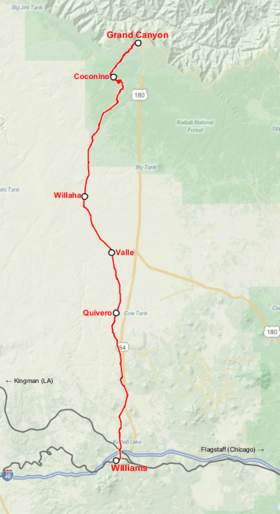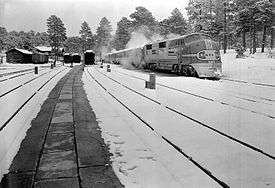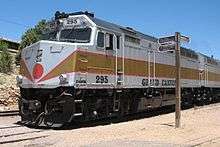Grand Canyon Railway
| Grand Canyon Railway | |
|---|---|
 | |
 | |
| Locomotive No. 4960 on the Grand Canyon Railway | |
| Locale | Coconino County, Arizona, USA |
| Terminus | Grand Canyon Village |
 | |
|
| |
| Commercial operations | |
| Built by | Atchison, Topeka and Santa Fe Railway |
| Original gauge | 4 ft 8 1⁄2 in (1,435 mm) standard gauge |
| Preserved operations | |
| Owned by | Philip Anschutz |
| Operated by | Grand Canyon Railway |
| Reporting mark | GCRY |
| Preserved gauge | 4 ft 8 1⁄2 in (1,435 mm) standard gauge |
| Commercial history | |
| Opened | 1901 |
| Closed to passengers | 1968 |
| Closed | 1974 |
| Preservation history | |
| 1988 | Max and Thelma Biegert Ownership |
| 1989 | reopened |
| 2006 | Xanterra ownership |
| 2008 | Transition to steam operation |
| 2008 | Expansion proposals |
| 2008 | Philip Anschutz ownership |
| Headquarters | Williams |
| Website | |
| http://www.thetrain.com | |
Grand Canyon Railway | |||||||||||||||||||||||||||||||||||||||||||||||||||||||||||||||||||||||||||||||||||||||||||||||||||||||||||||||||||||||||||||||||||||||||||||||||||||||||||||
|---|---|---|---|---|---|---|---|---|---|---|---|---|---|---|---|---|---|---|---|---|---|---|---|---|---|---|---|---|---|---|---|---|---|---|---|---|---|---|---|---|---|---|---|---|---|---|---|---|---|---|---|---|---|---|---|---|---|---|---|---|---|---|---|---|---|---|---|---|---|---|---|---|---|---|---|---|---|---|---|---|---|---|---|---|---|---|---|---|---|---|---|---|---|---|---|---|---|---|---|---|---|---|---|---|---|---|---|---|---|---|---|---|---|---|---|---|---|---|---|---|---|---|---|---|---|---|---|---|---|---|---|---|---|---|---|---|---|---|---|---|---|---|---|---|---|---|---|---|---|---|---|---|---|---|---|---|---|
Legend
| |||||||||||||||||||||||||||||||||||||||||||||||||||||||||||||||||||||||||||||||||||||||||||||||||||||||||||||||||||||||||||||||||||||||||||||||||||||||||||||
The Grand Canyon Railway (reporting mark GCRX), is a passenger railroad which operates between Williams, Arizona, and Grand Canyon National Park South Rim.
History
Santa Fe Ownership


In 1901, the Atchison, Topeka and Santa Fe Railway completed a branch line from Williams to Grand Canyon Village at the South Rim. The first scheduled train to carry paying passengers of the Grand Canyon Railway arrived from Williams on September 17 of that year. The 64-mile (103-kilometer) long trip cost $3.95, and naturalist John Muir later commended the railroad for its limited environmental impact. To accommodate travelers, the Santa Fe designed and built the El Tovar Hotel, located just 20 feet (6.1 meters) from the Canyon Rim. El Tovar opened its doors in January 1905.
Competition with the automobile forced the Santa Fe to cease operation of the Grand Canyon Railway in July 1968 (only three passengers were on the last run), although Santa Fe continued to use the tracks for freight until 1974.
Plans by entertainer Arthur Godfrey to resume service in 1977 fell through. In addition, two other companies attempted to resurrect the line in 1980 and 1984, with each attempt helping to maintain interest in preserving the line and saving it from scrapping.
Max and Thelma Biegert Ownership
In 1988, the line was bought by a Phoenix, Arizona, couple, Max and Thelma Biegert. The railway was restored and in 1989 began operations as a separate company, independent of the Santa Fe. The first run of the restored railroad was on September 17, 1989, commemorating the September 17 debut of the original railroad.[1]
The Biegerts, a couple originally from Nebraska, had made their fortune in crop dusting through Biegert Aviation, founded in 1947, which had a large federal government contract for its B-17 and later C-54 fleet.[2] After leaving the crop-dusting business, they operated a for-profit day care business in Houston, Texas, which became the Children's World Learning Center and is now part of KinderCare Learning Centers. The Biegerts never intended to get into the rail business. They had loaned money secured by the tracks to another person for the rail line. When they defaulted the Biegerts took over the line.[3] In conjunction with the start up, the Biegerts were principal investors in the short-lived Farwest Airlines which was an air taxi service intended to bring tourists from California, Las Vegas and Phoenix to Flagstaff where the passengers would then take the rail line.[4]

The railroad carries hundreds of passengers to and from the canyon every day, totaling about 240,000 passengers in 2006.
The restored Santa Fe Railway Station in Williams now serves the Grand Canyon Railway's daily Williams Flyer (Williams to/from Grand Canyon), Seasonal Polar Express, and is the terminus for other special events trains operated by the railway. The Williams Depot also offers twice daily Amtrak Thruway Motorcoach service connecting to/from Amtrak's Southwest Chief trains at Williams Junction.
The Grand Canyon Depot, owned by the National Park Service, remains the northern terminus for passengers of the line.
The railroad operates reconditioned 1970s (EMD F40PH) Diesel locomotives year-round. Passengers ride to/from the Grand Canyon in 1950s climate-controlled coaches. The railroad adds to the Old West experience by having actors dressed as bandits stage a mock train robbery during the return trip from the Grand Canyon to Williams.
During the winter season (November - January), the line runs The Polar Express from Williams to the 'North Pole', a station about 17 miles (30 km) north of town. The Polar Express service operates with restored 1920s vintage Harriman coaches. In 2008, this winter service carried about 78,000 passengers.
In February 2006, the Grand Canyon Railway announced that it had established a new logo that unifies all of the operating divisions of the company. The new 'glyph' style "G" herald harkens to the native American petroglyphs common in Northern Arizona. As of June 2007, the logo seems to be applied only to merchandise, signs, and official company letterhead, as several cars have come into service or been repainted while retaining the "drumhead" logo on the sides. Even freshly painted locomotives MLW FA-4 #6793 and steam locomotive #4960 have retained the old logo.

In March 2006, owners Max and Thelma Biegert announced to the media that they were placing the railroad and its associated restaurants, hotels and amenities up for sale. The combined properties had an annual revenue of nearly $40 million. The Biegerts sought a new buyer/operator with a possible theme park background, which would ensure that the railroad, hotels, RV park, restaurants (and a possible new amusement park in Williams) would continue to be operated as one entity.
Xanterra ownership
On September 21, 2006, it was announced that Xanterra Parks & Resorts of Denver, Colorado, submitted the winning bid (for an undisclosed sum) and was selected as the new owner for the Grand Canyon Railway. Xanterra is the corporate name and identity for what was originally known as the Fred Harvey Company, a legendary company with restaurant, hotel and service ties to the Atchison, Topeka & Santa Fe Railway as far back as 1876.
Xanterra said that it intended to keep all 480 of the railway's current employees, and planned to focus on growing the business and increasing the coordination between the railway and Xanterra's other services in the Grand Canyon National Park's South Rim. In the press release, the railway and Xanterra reported over 225,000 passengers and over $38 million in revenue in calendar year 2005. The purchase of the GCR included all of the railway's assets, land, depots, hotels, RV park, rolling stock, shops and linear pieces of land along the 65-mile (105 km) line. The Biegert family's 480-acre (194.2 ha) ranch near Gonzales Lake in north Williams was not included in the sale to Xanterra.
Transition of steam operation

In September 2008, Trains magazine reported that Xanterra would no longer operate its steam locomotives.[5] The decision came as a result of the 2000s energy crisis and the late 2000s recession conspiring against passenger numbers, although it was claimed to be an environmental decision. The railway's policy of always running a diesel with a steam locomotive as backup however does render the decision environmentally friendly. As part of the end of steam, 20 employees were laid off.[6] Around that time, both steam engines 29 and 4960 were placed on static display on the Williams Depot platform. Limited steam operation returned on September 19, 2009, with the engines being powered by waste vegetable oil. According to the GCR website, the service will be available during the 2011 season [7] with engine 4960. Over the winter of 2011/2012, engine 4960 underwent its 15-year overhaul and inspection, and returned to service in February 2012 for a special Centennial Run on February 14, 2012 celebrating 100 years of Arizona Statehood. Since then, engine 4960 continues to pull GCR excursions once per month during the summer months from May through September, and for special occasions.
Expansion proposals
Also in September 2008, the railway sought to double its number of daily trains. The National Park Service requested public comment on allowing "up to three round-trip passenger trains per day from Williams to the South Rim of the Grand Canyon National Park and one round-trip evening train ride per day from the South Rim to a short distance outside of the park."[8]
Philip Anschutz ownership
On June 24, 2008, it was announced that Philip Anschutz would buy Xanterra. Negotiations for the sale began on June 5[9] and the sale was completed on September 25.[10]
Operations
The Grand Canyon Railway offers one daily round trip from Williams to the Grand Canyon every day except December 25.
| Station | Train Schedule |
| Lv Williams | 9:30 a.m. |
| Ar Grand Canyon | 11:45 a.m. |
| Grand Canyon: | Enjoy Grand or Freedom
Guided Motor Coach Tour |
| Lv Grand Canyon | 3:30 p.m. |
| Ar Williams | 5:45 p.m. |
Historic designations
|
Grand Canyon Railway | |
|
Williams Depot | |
| Nearest city | Williams, Arizona |
|---|---|
| Area | 1,682 acres (681 ha) |
| Built | 1898 |
| Architectural style | Classical Revival |
| NRHP Reference # | 00000319[11] |
| Added to NRHP | August 23, 2000 |
The Grand Canyon Railway from Williams to the Grand Canyon National Park was listed in the National Register of Historic Places in 2000.
The Grand Canyon Depot is listed separately.
See also
- ATSF Grand Canyon Limited
- El Tovar Hotel
- History of the Grand Canyon area
- List of heritage railroads in the United States
- List of heritage railways
References
- ↑ "Grand Canyon Railway history".
- ↑ http://www.thetrain.com/news/presskit/legacy.cfm
- ↑ http://www.trainboard.com/grapevine/showthread.php?t=70525
- ↑ http://ronkilber.tripod.com/farwest/farwest.htm
- ↑ "Ridership loss, rising fuel prices drove GCR to cancel steam program". Trains (magazine). 2008-09-11. Retrieved 2008-09-14.
- ↑ "Top 10 railroad stories of 2008". Trains News Wire. 2008-12-31. Retrieved 2009-01-07.
- ↑ Steam event
- ↑ "Train Operations at Grand Canyon National Park - Public Scoping". 2008-09-04. Retrieved 2008-09-14.
- ↑ Whitehurst, Patrick (2008-06-24). "New ownership for Xanterra, GC Railway". Williams News. Retrieved 2008-06-25.
- ↑ "Xanterra Parks & Resorts Announces Completion of Sale to the Anschutz Company" (Press release). Xanterra Parks & Resorts. 2008-10-07. Retrieved 2008-12-08.
- ↑ National Park Service (2010-07-09). "National Register Information System". National Register of Historic Places. National Park Service.
External links
- Grand Canyon Railway official website
- History of Line
- More History of Line
| Wikimedia Commons has media related to Grand Canyon Railway. |


